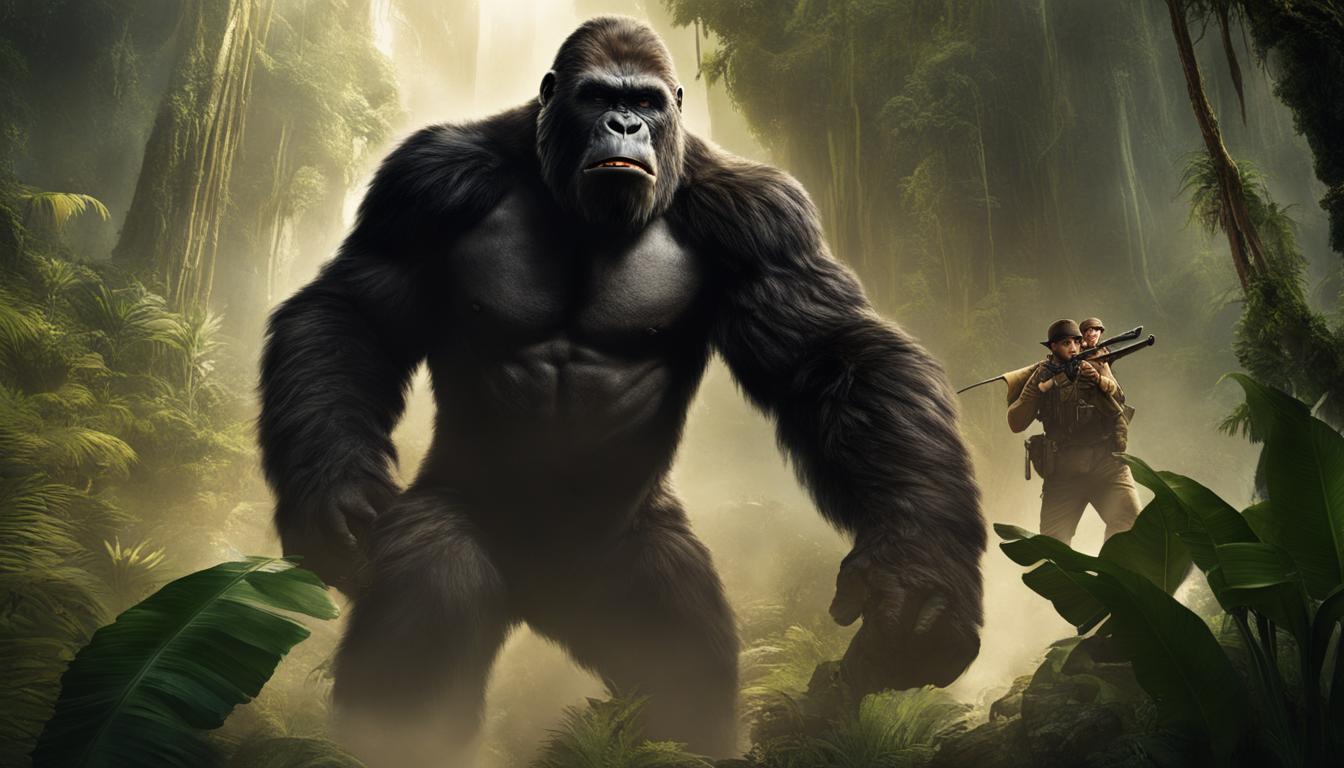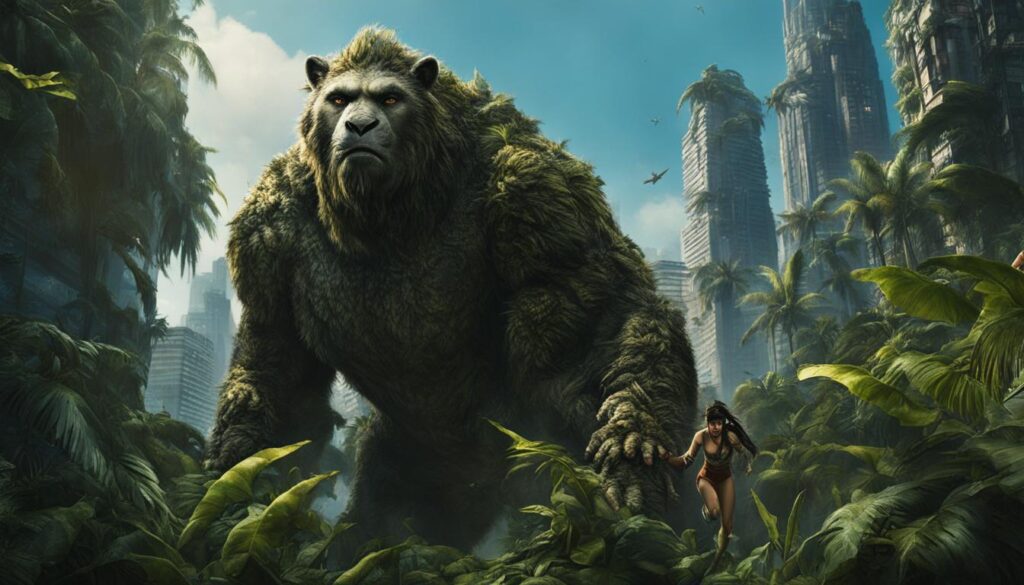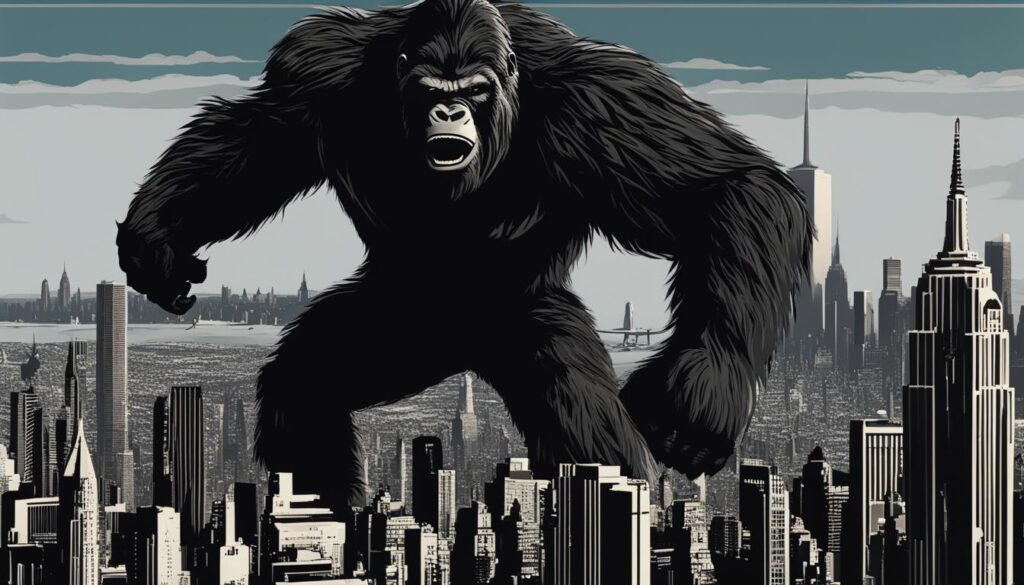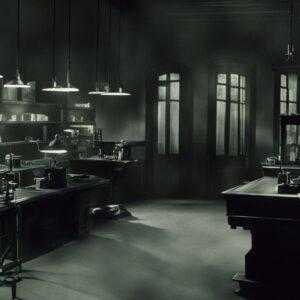Are you ready to embark on an adventure like no other? Let’s take a journey back in time to the golden age of cinema and explore the iconic world of King Kong (1933). This classic monster movie has captured the hearts of audiences for decades with its thrilling storyline, groundbreaking special effects, and unforgettable characters.
King Kong (1933) introduces us to a giant ape, the titular King Kong, who becomes the center of a daring and epic adventure. The film is a true testament to Hollywood history, showcasing the innovative use of stop-motion animation and paving the way for future cinematic masterpieces.
Key Takeaways:
- King Kong (1933) is a classic monster movie that has become an iconic piece of cinema.
- The film features a thrilling storyline and groundbreaking special effects.
- King Kong (1933) holds a significant place in Hollywood history, showcasing the innovative use of stop-motion animation.
- The film’s thrilling Skyscraper climbing scene is emblematic of its adventure-filled narrative.
- King Kong (1933) continues to captivate audiences with its timeless appeal and enduring legacy.
The Birth of King Kong (1933)
King Kong (1933) was brought to life through the collaborative efforts of producer Merian C. Cooper and writer Edgar Wallace. This iconic film was pitched to RKO Pictures, who took on the task of financing this ambitious project. The creation of King Kong required the use of innovative special effects, particularly the groundbreaking technique of stop-motion animation.
“King Kong was a film that pushed the boundaries of what was possible in visual storytelling,” said Willis H. O’Brien, the talented animator behind the film’s impressive effects.
Willis H. O’Brien, a master of stop-motion animation, was responsible for bringing Kong to life. This intricate process involved meticulously posing and photographing a model of the giant ape, frame by frame, to create the illusion of movement. The result was a thrilling and lifelike portrayal of King Kong that captivated audiences and set a new standard for special effects in the film industry.
This ambitious undertaking showcased the determination and creative vision of the filmmakers involved. The birth of King Kong (1933) marked a significant milestone in the evolution of cinema, paving the way for future advancements in special effects and solidifying the film’s place in Hollywood history.
The Birth of King Kong (1933) – Film Production Details
| Producer | Merian C. Cooper |
|---|---|
| Writer | Edgar Wallace |
| Studio | RKO Pictures |
| Special Effects | Willis H. O’Brien |
The birth of King Kong (1933) was made possible through the collaboration of visionary filmmakers, including producer Merian C. Cooper and writer Edgar Wallace. They approached RKO Pictures with their ambitious idea, and the studio agreed to finance the film. This decision set in motion a series of groundbreaking special effects that would change the course of cinema forever.
At the heart of the film’s visual effects was the innovative technique of stop-motion animation. Willis H. O’Brien, a pioneer in the field, was tasked with bringing the character of King Kong to life. Through his meticulous work, he crafted a lifelike and awe-inspiring depiction of the giant ape, captivating audiences with each frame.
The birth of King Kong (1933) marked a turning point in the history of film. Its ambitious production required the collaboration of talented individuals and the use of cutting-edge techniques. The result was a cinematic masterpiece that continues to captivate audiences and inspire future generations of filmmakers.
The Storyline and Themes
The storyline of King Kong (1933) takes audiences on a thrilling adventure that explores themes of beauty and the beast, as well as the consequences of exploration and exploitation. The film follows a group of brave explorers who venture to a remote island in search of a legendary giant ape known as King Kong.
Upon capturing Kong, they bring him back to New York City, where he manages to escape, resulting in chaos and destruction. The film delves into the complex relationship between Kong and the beauty he encounters in the city, highlighting the primal instincts and destructive power that lie beneath his colossal exterior.
Furthermore, King Kong (1933) serves as a cautionary tale about the consequences of human greed and the exploitation of the natural world. It portrays the consequences of tampering with forces beyond our control and delves into the destructive nature of human ambition. The film serves as a powerful commentary on the exploitation of both nature and individuals, reminding us of the fragile balance that exists between man and the environment.
Themes Explored in King Kong (1933)
- Beauty and the beast: The film presents a complex and fascinating portrayal of the relationship between Kong and the female lead, showcasing the dichotomy between his savage nature and the beauty he is drawn to.
- Exploration and discovery: King Kong (1933) takes viewers on an exciting journey into the unknown, highlighting the allure and dangers of exploration.
- Exploitation and consequences: The film shines a light on the consequences of exploiting nature and individuals, underscoring the destructive nature of human greed.
| Themes | Description |
|---|---|
| Beauty and the beast | The contrasting relationship between Kong and the female lead, showcasing the primal and vulnerable sides of both characters. |
| Exploration and discovery | The allure of venturing into the unknown and the dangers that come with it. |
| Exploitation and consequences | The destructive nature of human greed and the consequences of tampering with forces beyond our control. |
“King Kong (1933) presents a mesmerizing portrayal of the beauty and the beast archetype, exploring the intricate relationship between Kong and the female lead. The film serves as a cautionary tale about the consequences of human greed and the destructive nature of exploitation. It takes audiences on a thrilling adventure while delving into themes of exploration, beauty, and the consequences of tampering with nature. King Kong (1933) remains a powerful and thought-provoking classic.”
The Impact of King Kong (1933)
King Kong (1933) had a profound impact on the world of cinema and became a cultural phenomenon. The film’s pioneering special effects, particularly the groundbreaking use of stop-motion animation to bring the giant ape to life, revolutionized the industry. King Kong (1933) set new standards for visual storytelling and captivated audiences with its stunning visuals and thrilling storyline.
The film’s influence on future filmmakers cannot be overstated. It inspired generations of directors and artists to push the boundaries of what was possible in cinema. King Kong (1933) showcased the power of visual effects in storytelling and opened doors for advancements in technology in the years to come. The film continues to inspire and shape the work of filmmakers today.
“King Kong (1933) is a landmark film that left a lasting impact on the industry. Its pioneering special effects and gripping storyline have cemented its place in cinema history. It is a testament to the creativity and innovation of the filmmakers involved and continues to be celebrated and revered by audiences worldwide.”
The lasting cultural significance of King Kong (1933) is evident in its enduring popularity and the countless references and homages it has received in popular culture. The film’s timeless appeal and iconic status have made it a beloved classic, with its imagery and themes remaining relevant across generations. King Kong (1933) will forever be remembered as a groundbreaking film that left an indelible mark on the world of cinema.
| Aspect | Impact |
|---|---|
| Innovation in Special Effects | The pioneering use of stop-motion animation revolutionized the industry and set new standards for visual storytelling. |
| Influence on Filmmakers | King Kong (1933) inspired generations of directors and artists, shaping the future of cinema. |
| Cultural Phenomenon | The film became a cultural icon, with its imagery and themes referenced and celebrated in various forms of popular culture. |
The Legacy of King Kong (1933)
King Kong (1933) has left a lasting legacy in the world of cinema, inspiring numerous sequels, remakes, and pop culture references. The film’s enduring popularity is a testament to its impact on both audiences and filmmakers alike.
The legacy of King Kong (1933) can be seen in the success of its sequels, such as “Son of Kong” (1933) and “Mighty Joe Young” (1949), which expanded on the story and mythology of the original film. These follow-ups further solidified King Kong’s status as an iconic character in popular culture.
Additionally, the 2005 remake of King Kong directed by Peter Jackson demonstrated the continued fascination with the story and the enduring appeal of the giant ape. This modern retelling of the classic tale introduced the beloved character to a new generation of viewers.
King Kong (1933) has also made its mark in the realm of pop culture, with references and tributes appearing in various forms of media. From music to video games to theme park attractions, King Kong’s influence can be felt far and wide. The image of Kong scaling the Empire State Building has become an iconic and instantly recognizable symbol in our collective consciousness.
The Impact of King Kong (1933) on the Film Industry
In addition to its cultural impact, King Kong (1933) revolutionized the film industry with its innovative use of special effects and visual storytelling. The film’s groundbreaking stop-motion animation techniques, brought to life by Willis H. O’Brien, set a new standard for visual effects in cinema.
King Kong (1933) paved the way for future advancements in technology and inspired generations of filmmakers to push the boundaries of what was possible onscreen. The film’s success and influence can be seen in the evolution of special effects throughout the years, with modern blockbusters owing a debt to the pioneering work of Kong.
In conclusion, King Kong (1933) has left an indelible mark on cinema, with its legacy seen in the numerous sequels, remakes, and pop culture references that followed. The film’s impact on the film industry and its enduring popularity among audiences solidify its status as a timeless classic.
The Cultural Significance of King Kong (1933)
King Kong (1933) is not just a thrilling adventure film; it also holds significant cultural significance. The movie offers a commentary on colonialism and racism that reflects the racial and societal tensions of the time it was made. Kong, representing the “other,” embodies the consequences of exploitation and the destructive nature of colonialism. This provides a thought-provoking exploration of the consequences of human greed and the tampering with nature.
The film’s portrayal of Kong as a misunderstood creature caught in a world that fears and exploits him highlights issues of exploitation and the dehumanization of indigenous cultures. The narrative serves as a powerful metaphor, critiquing the negative impacts of colonization and shedding light on the racial biases prevalent in society during that era. King Kong (1933) thus serves as a testament to the power of cinema to challenge societal norms and provoke critical thinking.
“The film’s portrayal of Kong as a misunderstood creature caught in a world that fears and exploits him highlights issues of exploitation and the dehumanization of indigenous cultures.”
King Kong (1933) has been analyzed and interpreted in various ways, making it a subject of cultural analysis and academic discourse. Scholars have examined the film’s themes and symbolism in relation to questions of race, gender, and power dynamics. Its cultural significance continues to resonate with audiences, as it addresses timeless themes that remain relevant in contemporary society.
| Table: Cultural Significance of King Kong (1933) |
|---|
| Commentary on colonialism and racism |
| Provokes thought and discussion |
| Challenges societal norms |
| Subject of cultural analysis and interpretation |
The cultural significance of King Kong (1933) extends beyond its initial release. The film’s enduring legacy lies in its ability to spark meaningful conversations about social and cultural issues. It continues to captivate audiences who appreciate its thought-provoking exploration of themes and its commentary on the darker aspects of human nature.
Behind the Scenes: The Making of King Kong (1933)
Creating the iconic film, King Kong (1933), was no easy feat. The production faced numerous challenges and required groundbreaking techniques to bring the giant ape to life. Let’s take a closer look at the behind-the-scenes process and the innovative methods used to create this cinematic masterpiece.
One of the most notable production challenges was the use of stop-motion animation to animate Kong. This technique involved meticulously moving a model of Kong frame by frame to create the illusion of movement. It was a time-consuming process, with each second of film requiring multiple hours of work. However, the end result was nothing short of extraordinary.
“The making of King Kong (1933) was a true testament to the dedication and creativity of the filmmakers involved. The team behind the special effects had to constantly innovate and overcome technical limitations to bring this larger-than-life character to the screen.” – Film historian
In addition to stop-motion animation, the film also used groundbreaking techniques to create the illusion of scale. Miniature sets and models were used to depict Kong’s interactions with the human characters and the various environments he encounters. The crew meticulously crafted these detailed miniatures, ensuring every detail was accurate and believable on the big screen.
The production of King Kong (1933) pushed the boundaries of special effects and paved the way for future advancements in the industry. By overcoming the challenges of the time, the filmmakers created a timeless classic that continues to captivate audiences to this day.
| Production Challenges | Groundbreaking Techniques |
|---|---|
| Stop-motion animation | Creating the illusion of scale with miniature sets |
| Time-consuming process | Accurate and detailed miniatures |
| Technical limitations | Innovating to bring larger-than-life characters to the screen |
Critical Reception and Box Office Success
King Kong (1933) was met with critical acclaim upon its release, garnering praise for its groundbreaking special effects, thrilling storyline, and powerful themes. Critics were impressed by the film’s innovative use of stop-motion animation to bring Kong to life, with many praising the realistic portrayal of the giant ape. The Skyscraper climbing scene, in particular, was hailed as a cinematic marvel that showcased the technical prowess of the filmmakers.
The film’s box office success further solidified its status as a cultural phenomenon. It became one of the highest-grossing films of its time and captivated audiences with its thrilling adventure and larger-than-life characters. King Kong (1933) tapped into the public’s fascination with the unknown and the allure of the exotic, transporting viewers to a world filled with danger, excitement, and a touch of romance.
“King Kong is an extraordinary work of art. It combines the spectacle of a monster movie with compelling storytelling and thought-provoking themes,” said renowned film critic, Roger Ebert.
The cultural impact of King Kong (1933) cannot be overstated. The film set new standards for visual effects and influenced future filmmakers, inspiring generations of directors and artists to push the boundaries of what was possible in cinema. Its enduring popularity is a testament to its timeless appeal and its ability to captivate audiences across generations.
The table below highlights some of the critical reception and box office milestones of King Kong (1933):
| Critical Reception | Box Office |
|---|---|
| Great performances and memorable visual effects make this a must-see film. | Grossed over $5 million at the box office during its initial release. |
| “A thrilling and visually stunning adventure that pushes the boundaries of what can be achieved in cinema.” | Became one of the highest-grossing films of the 1930s. |
| “King Kong is a cinematic masterpiece that continues to captivate audiences with its groundbreaking special effects and powerful storytelling.” | Remained popular in re-releases and has generated significant revenue over the years. |
| “The film’s enduring popularity is a testament to its timeless appeal and its ability to resonate with audiences across generations.” | Has spawned numerous sequels, remakes, and spin-offs, further contributing to its box office success. |
King Kong (1933) and the Evolution of Special Effects
King Kong (1933) played a pivotal role in the evolution of special effects in cinema. The film’s use of stop-motion animation was groundbreaking and showcased the potential of visual effects in storytelling. Before King Kong, special effects were primitive and limited, but the film’s innovative techniques opened up new possibilities for filmmakers.
Stop-motion animation, which involved manipulating miniature models and capturing them frame by frame, was a labor-intensive process. However, it allowed Kong to come to life onscreen in a way that had never been seen before. The attention to detail and the fluidity of Kong’s movements mesmerized audiences and set a new standard for realism in special effects.
“It was the marvel of its day. King Kong represented a major leap forward in special effects, dazzling audiences with its lifelike creature and immersive storytelling.” – Film Critic
The success of King Kong inspired filmmakers to push the boundaries of what was possible with special effects. Advancements in technology and the use of new techniques, such as miniatures and animatronics, were direct results of the groundbreaking work done in King Kong. Filmmakers realized that the possibilities were endless, and they began to experiment with different methods to create more realistic and visually stunning effects.
| Advancements in Special Effects | Impact on Filmmaking |
|---|---|
| The use of miniatures and models | Allowed for the creation of elaborate sets and realistic environments |
| Animatronics | Enabled filmmakers to create lifelike creatures and characters |
| Matte painting | Provided a cost-effective way to create realistic backgrounds |
Today, special effects have become an integral part of filmmaking, with computer-generated imagery (CGI) taking center stage. However, the techniques pioneered in King Kong laid the foundation for the advancements we see in modern cinema. Without the groundbreaking work done in the 1933 film, the special effects landscape would not be what it is today.
King Kong (1933) continues to be a testament to the power of visual effects in storytelling. The film’s innovative use of stop-motion animation captivated audiences and set a new standard for realism in special effects. It remains a timeless classic that has left an indelible mark on cinema, inspiring future filmmakers and paving the way for the evolution of visual effects in the industry.
The Enduring Popularity of King Kong (1933)
King Kong (1933) continues to captivate audiences and maintain its enduring popularity, even after more than eight decades. The film’s timeless appeal and iconic status have made it a beloved classic in the realm of cinema. Generation after generation, King Kong (1933) continues to be referenced and celebrated in popular culture, showcasing its lasting impact and cultural significance.
The nostalgia surrounding King Kong (1933) contributes to its enduring popularity. The film holds a special place in the hearts of many who have grown up watching it or have been introduced to it through subsequent remakes and spin-offs. Its groundbreaking special effects and thrilling storyline continue to mesmerize audiences, proving that the allure of King Kong transcends time.
King Kong (1933) has had a profound cultural impact that extends beyond the world of cinema. The giant ape has become an enduring symbol and has inspired a dedicated fan culture. From merchandise to theme park attractions, King Kong (1933) has left a lasting impression on popular culture, further solidifying its place as a cultural phenomenon.
The Timeless Appeal of King Kong
One of the reasons for the enduring popularity of King Kong (1933) is its ability to resonate with audiences across different generations. The film’s themes of beauty and the beast, exploration, and the consequences of exploitation are universal and continue to strike a chord with viewers today. King Kong (1933) serves as a reminder of the power of storytelling and the lasting impact that a well-crafted film can have on popular culture.
In conclusion, King Kong (1933) stands as a timeless classic that has left an indelible mark on cinema history. Its enduring popularity, cultural impact, and timeless appeal can be attributed to its groundbreaking special effects, captivating storyline, and powerful themes. King Kong (1933) continues to inspire and entertain audiences, cementing its place as one of the greatest films of all time.
King Kong (1933) in the Context of Hollywood History
King Kong (1933) holds a significant place in Hollywood history, representing a milestone in cinematic storytelling and technical achievement. The film was released during the Golden Age of Hollywood, a period known for its prolific output of classic films. King Kong (1933) stands out as one of the most iconic and influential movies of this era, showcasing the creativity and innovation of filmmakers at the time.
During the Golden Age of Hollywood, the studio system dominated the film industry, with major studios producing and distributing a vast number of movies. King Kong (1933) was a testament to the power and influence of the studios, as RKO Pictures backed the ambitious project and brought it to the big screen. The success of the film further solidified the studio system’s control over the industry, setting the stage for future blockbusters and establishing the template for the modern Hollywood blockbuster.
“King Kong (1933) represents a milestone in cinematic storytelling and technical achievement.”
King Kong (1933) is not only a cultural landmark but also a significant cinematic milestone. The film’s groundbreaking special effects, including the use of stop-motion animation to bring Kong to life, revolutionized the industry and paved the way for advancements in visual effects technology. Its impact on future filmmakers can be seen in the way it inspired generations of directors and artists to push the boundaries of what was possible onscreen. Today, the techniques pioneered in King Kong (1933) continue to influence and shape the way movies are made.
| Golden Age of Hollywood | Cinematic Milestones |
|---|---|
| 1930s to 1950s | King Kong (1933) |
| Studio system dominance | Groundbreaking special effects |
| Mass production of classic films | Inspiration for future filmmakers |
King Kong (1933) remains a testament to the rich history of Hollywood and its enduring impact on cinema. The film’s innovative techniques and storytelling continue to captivate audiences, showcasing the timeless appeal of a true cinematic masterpiece.
Impact on Future Filmmakers
King Kong (1933) has left a lasting impression on future filmmakers, serving as a source of inspiration and influencing the industry for decades. Its groundbreaking special effects and innovative storytelling techniques continue to shape the way movies are made today. The film’s cultural significance and enduring popularity have solidified its place as a cinematic milestone.
King Kong (1933) introduced audiences to the power of visual effects and showcased the potential of storytelling through technology. Filmmakers have paid homage to the film through visual references, themes, and storytelling elements in their own works, further demonstrating its influential impact on the industry. The awe-inspiring size and presence of King Kong, brought to life through the film’s pioneering use of stop-motion animation, have inspired generations of artists to push the boundaries of what can be achieved on the big screen.
“King Kong (1933) opened up endless possibilities for filmmakers, showing us that imagination knows no bounds. It taught us that we can create entire worlds and bring mythical creatures to life through the magic of cinema. It’s a testament to the power of storytelling and the impact a single film can have on an entire industry.”
Influenced by the creativity and innovation of King Kong (1933), filmmakers have expanded their imaginations and embraced advancements in technology to create unforgettable movie experiences. The film’s legacy lives on in the works of directors who continue to be inspired by its timeless appeal and continue to push the boundaries of what is possible in the world of cinema.
Inspiration for Future Generations
King Kong (1933) has served as a source of inspiration for future generations of filmmakers. Its impact on the industry cannot be overstated, as it not only revolutionized special effects and storytelling techniques but also solidified the potential of cinema as an art form. The film’s enduring popularity and cultural significance continue to captivate audiences, ensuring that King Kong’s legacy will be cherished for years to come.
Cultural Analysis and Interpretation
King Kong (1933) has been the subject of extensive cultural analysis and interpretation. The film’s themes and symbolism have been explored in relation to issues of race, gender, colonialism, and exploitation. Critics and scholars have dissected the film, uncovering layers of meaning and highlighting its social and cultural significance.
One of the key areas of analysis revolves around the symbolism of King Kong himself. Many interpretations view Kong as a representation of the “other,” an embodiment of fear and fascination with the unknown. This interpretation aligns with the racial tensions of the time, as Kong is captured and brought to New York City, where he becomes a spectacle for human entertainment.
“King Kong (1933) is a powerful allegory for the destructive nature of colonialism and the consequences of exploitation.”
Additionally, King Kong (1933) has been examined through the lens of colonialism and its destructive impact on indigenous cultures. The film’s storyline, with explorers venturing to a remote island to capture Kong, mirrors the exploitation and domination of native populations by Western powers. King Kong (1933) underscores the arrogance and consequences of tampering with nature and the destructive nature of human greed.
Furthermore, feminist analysis of the film has focused on the representation of women and their relationship with Kong. Some argue that the character of Ann Darrow, played by Fay Wray, represents the damsel in distress trope, relying on the male characters to save her. Others view Ann as a symbol of resilience and strength, forming a connection with Kong that transcends societal expectations.
King Kong (1933) continues to provoke thought and discussion, inviting audiences to analyze its themes and symbolism through different perspectives. The film’s cultural analysis highlights its enduring impact and its position as a captivating piece of cinematic history.
The Enduring Fascination with King Kong (1933)
King Kong (1933) has captured the hearts and imaginations of fans for generations, leading to an enduring fascination with the iconic giant ape. From its release to the present day, King Kong (1933) has inspired a vibrant fan culture that continues to thrive. Fans of all ages have embraced the majestic creature, forming a dedicated community that celebrates the film’s rich legacy.
The enduring fascination with King Kong (1933) is evident in the vast array of merchandise that pays homage to the beloved character. Fans can find everything from action figures and artwork to clothing and collectibles, allowing them to showcase their love for the film in unique ways. The popularity of King Kong (1933) merchandise is a testament to the lasting impact of the film and its enduring place in popular culture.
Additionally, King Kong (1933) has become a staple in the world of theme park attractions. Visitors can experience the thrill of encountering the mighty Kong firsthand through immersive rides and exhibits. These attractions not only provide entertainment but also serve as a fitting tribute to the enduring legacy of King Kong (1933) and its significance in cinematic history.
Theme Park Attractions Featuring King Kong (1933)
| Theme Park | Attraction | Description |
|---|---|---|
| Universal Studios Hollywood | King Kong 360 3-D | An intense 3-D experience that takes guests on a treacherous journey through Skull Island, with Kong battling various creatures along the way. |
| Universal Orlando Resort | Skull Island: Reign of Kong | A thrilling expedition into the heart of Skull Island, where guests encounter the awe-inspiring Kong and face perilous encounters with other creatures. |
| Universal Studios Japan | Flight of the Hippogriff | A family-friendly roller coaster that takes guests on a journey through the Forbidden Forest, where they encounter a magical encounter with Kong. |
The enduring fascination with King Kong (1933) is a testament to the film’s timeless appeal and its ability to captivate audiences across generations. Whether it’s through the collectibles and merchandise that allow fans to bring Kong into their homes, or the thrilling theme park attractions that provide an immersive experience, the legacy of King Kong (1933) continues to resonate with fans worldwide.
Conclusion
In conclusion, King Kong (1933) is a timeless classic that has had a profound impact on the world of cinema. The film’s groundbreaking special effects, thrilling storyline, and powerful themes have captivated audiences for generations. From its iconic Skyscraper climbing scene to its exploration of beauty and the beast, King Kong (1933) continues to resonate with viewers today.
The legacy of King Kong (1933) is undeniable. Its influence on future filmmakers can be seen in the advancements in special effects and visual storytelling techniques. The film’s success paved the way for the development of the monster movie genre and firmly established Kong as a cultural icon.
King Kong (1933) is not just a movie, but a true milestone in cinema history. Its cultural significance and enduring popularity have solidified its status as a timeless classic. The film’s gripping storyline, innovative special effects, and social commentary on colonialism and exploitation make it a must-watch for cinephiles around the world.
Whether you’re a fan of adventure films, a lover of Hollywood history, or simply looking to experience a timeless classic, King Kong (1933) is a film that should not be missed. Its impact on cinema and its place in popular culture make it a true masterpiece that continues to leave its mark on audiences to this day.
FAQ
What is King Kong (1933)?
King Kong (1933) is a classic monster movie that tells the story of a giant ape named King Kong who is captured and brought to New York City, where he escapes and wreaks havoc.
Who were the creators of King Kong (1933)?
King Kong (1933) was the brainchild of producer Merian C. Cooper and writer Edgar Wallace.
What were the groundbreaking special effects used in King Kong (1933)?
King Kong (1933) used groundbreaking stop-motion animation to bring the character of Kong to life.
What is the storyline and themes of King Kong (1933)?
The film follows a group of explorers who capture Kong and bring him to New York City. It explores themes of beauty and the beast, as well as the consequences of exploitation and tampering with nature.
What was the impact of King Kong (1933) on the film industry?
King Kong (1933) revolutionized the industry with its pioneering use of special effects and realistic portrayal of Kong. It inspired future filmmakers and set new standards for visual storytelling.
What is the legacy of King Kong (1933)?
King Kong (1933) has spawned sequels, remakes, and countless pop culture references. It is considered a timeless classic and has had a lasting impact on cinema.
What is the cultural significance of King Kong (1933)?
King Kong (1933) reflects the racial and societal tensions of its time and serves as a commentary on colonialism and exploitation.
How was King Kong (1933) made?
The film required innovative techniques and groundbreaking special effects, including the complex process of stop-motion animation, to bring Kong to life.
What was the critical reception and box office success of King Kong (1933)?
King Kong (1933) was a critical and commercial success, receiving positive reviews and becoming one of the highest-grossing films of its time.
How did King Kong (1933) influence the evolution of special effects in cinema?
King Kong (1933) paved the way for advancements in special effects technology and inspired filmmakers to push the boundaries of what was possible onscreen.
Why does King Kong (1933) continue to be popular today?
King Kong (1933) has a timeless appeal and enduring popularity due to its thrilling storyline, groundbreaking special effects, and powerful themes that resonate with audiences.
What role did King Kong (1933) play in Hollywood history?
King Kong (1933) represents a milestone in cinematic storytelling and technical achievement, and it played a significant role in the Golden Age of Hollywood.
How did King Kong (1933) inspire future filmmakers?
King Kong (1933) inspired generations of directors and artists with its groundbreaking special effects and innovative storytelling techniques.
What has been the cultural analysis and interpretation of King Kong (1933)?
King Kong (1933) has been analyzed for its themes, symbolism, and reflection of the social and cultural climate of its time.
Why does King Kong (1933) have an enduring fascination with fans?
King Kong (1933) has become a beloved and iconic character, inspiring a dedicated fan culture and continuing to captivate new generations of fans.







